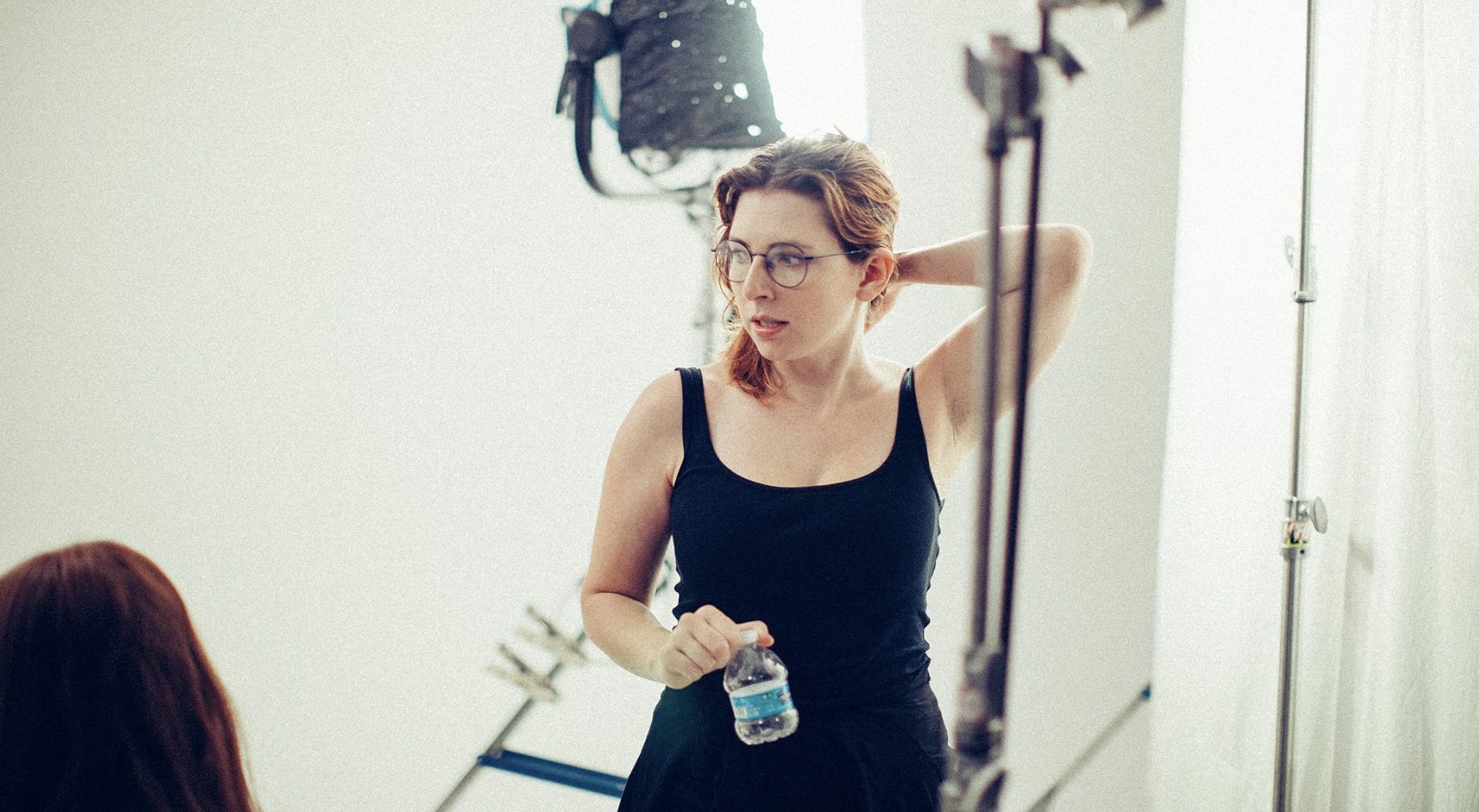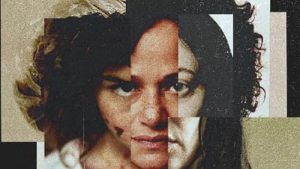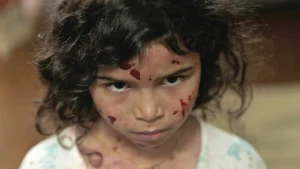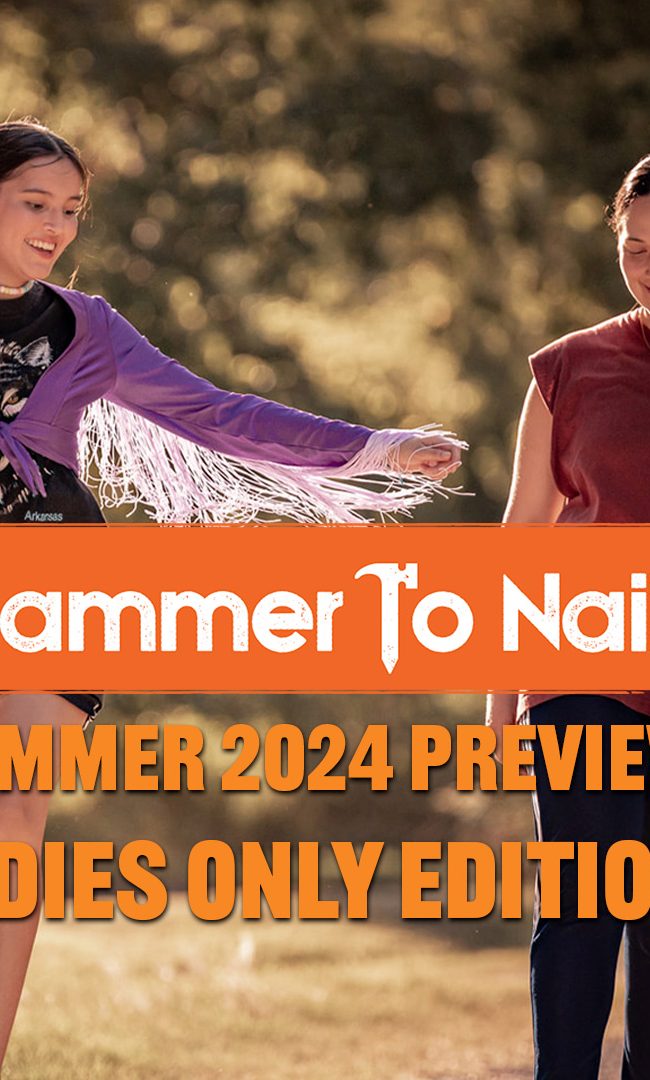A Conversation with Laura Moss (birth/rebirth)

A modern retelling of Frankenstein, birth/rebirth [which recently debuted on Shudder] finds director Laura Moss toying with the life of the six-year-old daughter of Celie (Judy Reyes), a nurse who works in the same hospital as post-mortem pathologist Rose (Marin Ireland). When Lila’s corpse goes missing, Rose follows the clues back to Celie’s apartment, where the morally-questionable scientist has Rose’s daughter alive once more. As the two women work to carry on the experiment, for very obviously different reasons, the danger and tension brings them together as a bizarre sort of family.
The film premiered in the midnights section at Sundance, which was possibly the best and worst location for this story. The genre trappings cast dead-cold shadows over a very human story of the warmth of a mother’s love. With two powerhouse performances, the film fills every corner of its claustrophobic apartment and hospital laboratory setting. Moss’s direction, despite it being her first feature film, is confident and elegant, framing a universal story inside a very particular sensory palette, where the audience is surrounded by heart monitors that beat with the irregular tension of hope and the and stale stench of DoorDash discards abandoned days ago when despair threatened to dwarf that prospect.
I had a chance to sit down with Moss for a virtual interview conducted long after my leg had fallen asleep from the cat napping in my lap. [Editors note: Laura Moss won the Hammer to Nail Winter 2017 Short Film Contest with her stunning short Fry Day.]
Hammer to Nail: He refuses to leave my lap right now.
Laura Moss: I love that.
HtN: I mean, it’s kind of an interesting segue into your film, because he’s very old and he’s dying, and so I am spending the last every second I can with him, and I just don’t want to stop because it’s – sorry not going to cry.
LM: How long have you had him?
HtN: 16 years and seven months.
LM: Oh my gosh.
HtN: Yeah. Yeah. He’s super special and he’s very empathetic. He also loves Zoom meetings. He really enjoys hearing other people talking, for some reason. I don’t know.
LM: That’s very funny. What’s his name?
HtN: Buttons.
LM: Buttons. I had a cat named Sweaters with very much the same coloring.
HtN: I love that. Sweaters, that’s great. So you can see, I really appreciated you film, the way you are willing to do anything to keep your baby. It’s a special film. It is so beautiful and so difficult. It’s one of those things that I think is really special. It’s not an easy film, but It rewards the viewer with something very unique.
LM: Yeah, it’s pretty gut-wrenching from a creation perspective to work on something like this. And it also took a long time, about six years, and so there have been peaks and valleys. There was a period I was working with my co-writer, Brendan O’Brien, where I just became completely disenchanted with the movie. I was just like, “This is too much. I can’t handle it.” We went through every page and I was like, “No, no, no, no.” And I think what I realized at that moment was, that version of the script was very similar to what is on screen, except it was devoid of humor. It was just… and it killed me.
HtN: Wow. I can imagine. Because humor is so essential to how humans respond to difficult situations. I think my favorite moment is when she’s turning the TV on and off and getting her patient to moan on the basis of the pushing the button.

A graphic from birth/rebirth
LM: That was great. Marin never breaks character, but we had her cracking up on set at that moment, definitely. I really had to find not just the light, which there is in this piece, what are the characters moving towards, but also what is inherently funny about this tragic situation. And I think that’s really when the odd couple dynamic between these women started to come out more, and I really started to acknowledge the fact that this Frankenstein is a melodrama and there’s humor in melodrama.
HtN: I really love the dynamic between the two actresses. It became this very interesting couple, in a way, and I think it’s interesting the way two people who are going towards the same goal end up sort of as a unified duo, even if they’re very, very different people.
LM: Yeah. I think [there] is the unifying element of that experience of having to care for and be responsible for the life of a child. In many ways, Celie represents motherhood in this movie and Rose represents career, although of course Celie has her own career as a maternity nurse, and I really wanted to explore these two facets of life that are often pitted against each other, especially when someone chooses to have a child. And very often people who choose one path tend to have judgments about people who are on the other path. And so to me it was really important that these women not only cross, but bond. And ultimately then at the end of the film, I think The Other is the only one who can understand their experience. And Judy and Marin, who had never met at the outset of this film, we didn’t have a lot of rehearsal time, really ended up bonding over the course of shooting. We didn’t shoot exactly in order, but we ended in the apartment, and so we were able to organically create that experience for them as well.
HtN: When you have a film that is 90% two actresses, that’s a lot of trust. I know when you are writing a script like that, you’re like, “Oh, I hope I find the right people for this, because if I can’t find them, then that’s the movie.”
LM: It lives and dies by the actors, it’s absolutely true. And I had Judy in mind from the outset when we were writing this. Marin was one of my top choices. But of course I’d never met them and I didn’t know how it would be to work with them. It’s a terrifying prospect to make an offer to an actor and not know what you’re going to get. And I should have known, because Marin’s such a storied theater actress and Judy has such deep experience in television that their stamina on an independent film set and their work ethic, it was phenomenal, and they were just both really open and humble. As a first time feature director, it’s really the most I could ask for.
HtN: I’m curious, as a first time director tackling motherhood, when that’s not something you’ve personally gone through, what drew you to that?
LM: I think filmmaking to me is a way to process big questions that I have for myself, and having a baby was a big question that I think I may have answered in the making of this film. And Rose herself, our Dr. Frankenstein of the story, she has been pregnant, as have I, but she has not been through the child birthing experience. So in some ways, I was on one side of a coin for these two women. I had the experience of one of these women.
It was crucial to me that I work with collaborators who came from the other experience, and [Director of Photography] Chananun Chotrungroj, whose child is now five years old… I mean, particularly the C-section that opens the film … she went through an emergency C-section. So to be able to talk about that from a really personal first person perspective with Chananun was instrumental in making that feel authentic, I think.
HtN That’s great. It’s interesting, the film, it’s playing as a genre film, obviously. It’s going to be on Shudder. It’s very dramatic, though. It’s not scary. I think from a genre perspective, the only thing that makes it genre is the Frankenstein storyline. But other than that, you’ve kind of stripped it of all the scary moments, except …. [SPOILER] in my brain there’s one thing that I kept coming back to, which is that when her child saw the pig, she killed the pig pretty violently, right off the bat. And I’m like, okay, we don’t know how she’s going to develop as a child, but who knows if there’s something inside of her that has no soul, that is destructive? I don’t know. I’m love the dark side of the film. [END SPOILER]
LM: Yeah. I mean, it’s interesting. I’m a huge horror fan of traditional horror and out there horror, art house horror. I love all of it. And that’s why I actually think we were really good partners with Shudder because they have a really expansive definition of horror. Last year alone you saw Skinamarink and Speak No Evil on their roster, and those are wildly different films to birth/rebirth and wildly different films to each other. David Cronenberg’s Dead Ringers is a huge influence on this film and I don’t know what you call that…
HtN I’d call it Cronenberg. I feel like he has his own genre.
LM: He does have his own genre. So for me, I like to think of my work as kind of genre adjacent. If you are a fan of horror, you might like this work, but it is not traditional horror. I do find in pitching and selling a script to potential collaborators and investors it’s almost necessary to play up some horror elements. The IP of Frankenstein was a huge part of our ability to get this film made. And so you’re always kind of doing that dance, but I was able to be pretty upfront with our executives at Shudder about the kind of movie that I wanted to make, and I was really happy that they were excited to make that movie too.

A still from birth/rebirth
HtN: I love it. Talk to me about your discussions with the DP in terms of the look of the film, especially since you had a good working relationship and went to school with her.
LM: She’s incredibly visual and it’s like she has an encyclopedic knowledge of film and photography. So we had a very short chat about the script. Basically, she said, “I like it,” and that was the end of the Zoom, and two days later, she presented me with a 148-page lookbook that was basically the images that were in script order. That’s really how I love to work. My background is production design, and batting images back and forth and then trying to figure out why they work for us or why they don’t is really key.
We had a Google Doc where it was technically a shot list, but it was more like reference images for every scene that I had access to on an iPad every day, and I think made a few rules for ourselves. We knew that the camera wanted to be patient, observational, sort of like the audience was watching the film from a scientist’s perspective.
HtN: It’s close and it’s claustrophobic, like its under a microscope, which is I’m sure was intentional, because I feel like it does have that technical view, but it also is how you approach a child. I mean, you want to be as close as possible and fill their whole face, and they want to connect with the world and bring it closer. Did you get to shoot at an actual hospital?
LM: We did. It was decommissioned. Basically, I think it was a physical therapy center that then was retrofitted as a COVID overflow hospital and then not used. So it was a large space in New Jersey that I can’t say the name of it, but a medical procedural was canceled right when we were shooting, and we were able to borrow a great number of set pieces from them and then return them.
HtN: Because they were accidentally left behind?
LM:: Yeah. We were able to get amazing bang for our buck, production value wise. Hospitals are expensive to shoot in and to dress, and I think the stars aligned for us on this one.
HtN: I love it. I’d love to just talk about the title. birth/rebirth I love the way you just framed the entire film in two words with the slash. I don’t know, I think it’s very evocative, and I’m curious if that was always the title.
LM: Oh, I’m so glad that you say that. I submitted this for the first time to the Sundance Labs in, I think, 2018 and had to come up with a title, so I did, and it was birth/rebirth, lowercase with a slash. And I thought, “Surely someone will come up with a better one,” but I didn’t and no one else did. And over time, now that I’m living with it for a long time, it’s really grown on me. I feel like it evokes the cyclical nature of the film to some degree, and there’s something about the lowercase that the sort of femme landscape of the film that felt like lowercase in the title serves that.
– Bears Rebecca Fonté (@BearsFonte)











